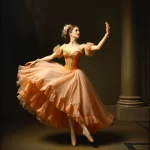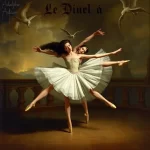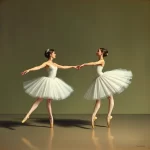Ballet: Catarina or La Fille du bandit (Cesare Pugni, 1846)

Introduction
Ballet, an art form that combines dance, music, and storytelling, has produced numerous masterpieces over the centuries. One such gem is “Catarina, or La Fille du Bandit,” a ballet composed by Cesare Pugni and choreographed by Jules Perrot. Premiered in 1846, this ballet tells a captivating story of love, betrayal, and redemption set against a backdrop of banditry and adventure.
Cesare Pugni, a prolific composer known for his extensive work in ballet music, collaborated with Jules Perrot, one of the most influential choreographers of the Romantic era, to bring this ballet to life. The premiere took place at Her Majesty’s Theatre in London, marking a significant event in the history of ballet.
The plot revolves around Catarina, the daughter of a bandit, who finds herself entangled in a web of love and danger. Through a series of dramatic events, the ballet explores themes of loyalty, courage, and the transformative power of love.
Historical Background
Creation and Development
The mid-19th century was a period of significant transformation in the world of ballet. The Romantic era, characterized by its emphasis on emotion, nature, and the supernatural, had a profound influence on the arts. “Catarina, or La Fille du Bandit” was created within this context, drawing inspiration from the Romantic fascination with exotic locales and dramatic narratives.
The ballet was inspired by various literary sources and folklore, which were popular themes during the Romantic period. The collaboration between Cesare Pugni and Jules Perrot was instrumental in shaping the ballet. Pugni’s music, known for its melodic richness and emotional depth, complemented Perrot’s innovative choreography, which emphasized expressive movement and dramatic storytelling.
Premiere and Reception
“Catarina, or La Fille du Bandit” premiered on August 3, 1846, at Her Majesty’s Theatre in London. The initial reception was overwhelmingly positive, with both critics and audiences praising the ballet for its compelling narrative, beautiful music, and captivating choreography.
Notable early performances featured some of the most celebrated dancers of the time, including Carlotta Grisi in the role of Catarina. The ballet’s success led to numerous revivals and adaptations, solidifying its place in the repertoire of major ballet companies.
Synopsis of the Ballet
Act I Summary
The ballet opens with a picturesque village scene, where the villagers are celebrating a festival. Catarina, the daughter of a notorious bandit, is introduced. Despite her father’s criminal background, Catarina is loved by the villagers for her kindness and beauty. During the festivities, she meets and falls in love with a young nobleman named Fernando.
However, their budding romance is threatened by the arrival of a group of bandits led by Catarina’s father. The bandits plan to rob the village, but Catarina, torn between her love for Fernando and her loyalty to her father, decides to warn the villagers. This act of bravery sets the stage for the unfolding drama.
Act II Summary
In the second act, the tension escalates as the bandits prepare for their raid. Catarina’s father discovers her betrayal and confronts her. In a dramatic confrontation, Catarina pleads for mercy, revealing her love for Fernando. Moved by her sincerity, her father reluctantly agrees to spare the village but insists that Catarina must leave with the bandits.
Fernando, determined to rescue Catarina, follows the bandits to their hideout. A series of thrilling events ensue, including a daring escape and a fierce battle between Fernando and the bandits. Ultimately, love triumphs as Fernando and Catarina are reunited, and her father, realizing the error of his ways, decides to turn over a new leaf.
Finale
The ballet concludes with a joyous celebration as Catarina and Fernando return to the village. The villagers welcome them with open arms, and Catarina’s father, now reformed, seeks forgiveness for his past deeds. The finale is a testament to the power of love and redemption, leaving the audience with a sense of hope and renewal.
Musical Composition
Composer’s Role
Cesare Pugni, an Italian composer renowned for his contributions to ballet music, played a pivotal role in the creation of “Catarina, or La Fille du Bandit.” Pugni’s score is characterized by its lyrical melodies, dynamic rhythms, and rich orchestration, which enhance the emotional depth and dramatic intensity of the ballet.
Notable pieces within the score include the vibrant village festival music, the hauntingly beautiful love theme for Catarina and Fernando, and the dramatic battle music that underscores the climactic confrontation between Fernando and the bandits.
Musical Themes and Motifs
Pugni’s score features several recurring musical themes and motifs that help to unify the narrative and underscore the emotional arcs of the characters. The love theme for Catarina and Fernando is a central motif, symbolizing their deep connection and the transformative power of their love.
Other notable motifs include the ominous theme associated with the bandits, which creates a sense of tension and danger, and the uplifting village festival music, which conveys the joy and camaraderie of the villagers. These musical elements work together to enhance the storytelling and evoke a range of emotions in the audience.
Famous Recordings and Performances
Over the years, “Catarina, or La Fille du Bandit” has been performed by numerous ballet companies around the world. Some of the most iconic recordings and performances include those by the Bolshoi Ballet and the Mariinsky Ballet, both of which have brought their unique interpretations to the ballet.
These performances have been praised for their exceptional musicality, technical precision, and emotional depth, making them a valuable resource for both ballet enthusiasts and scholars.
Choreography and Dance
Choreographer’s Vision
Jules Perrot, a master choreographer of the Romantic era, brought his visionary approach to “Catarina, or La Fille du Bandit.” Perrot’s choreography is characterized by its expressive movement, dramatic storytelling, and innovative use of dance to convey complex emotions and relationships.
Perrot’s vision for the ballet was to create a seamless blend of dance and narrative, where each movement and gesture would contribute to the overall storytelling. His choreography emphasized the emotional journey of the characters, using dance as a powerful medium to explore themes of love, loyalty, and redemption.
Signature Dance Numbers
The ballet features several signature dance numbers that have become iconic in the world of ballet. One of the most notable is the Pas de Deux between Catarina and Fernando, a beautiful and emotionally charged duet that showcases their love and connection.
Other key dances include the vibrant village festival scenes, which feature lively group dances and solos that capture the joy and camaraderie of the villagers, and the dramatic battle scenes, which are characterized by their dynamic and intense choreography.
Notable Interpretations
Over the years, “Catarina, or La Fille du Bandit” has been interpreted and adapted by various choreographers and ballet companies. Each production brings its unique perspective to the ballet, highlighting different aspects of the story and characters.
Notable interpretations include those by the Bolshoi Ballet, which emphasized the dramatic and emotional intensity of the ballet, and the Mariinsky Ballet, which focused on the lyrical and expressive qualities of the choreography. These interpretations have contributed to the ballet’s enduring popularity and relevance.
Characters and Roles
Main Characters
- Catarina: The daughter of a bandit, Catarina is a kind and courageous young woman who finds herself torn between her love for Fernando and her loyalty to her father.
- Fernando: A nobleman who falls in love with Catarina. He is determined to rescue her from the bandits and prove his love and loyalty.
- Catarina’s Father: The leader of the bandits, he is a complex character who ultimately seeks redemption for his past deeds.
Supporting Characters
- The Villagers: The villagers play a significant role in the ballet, representing the community and providing a backdrop for the unfolding drama.
- The Bandits: The bandits add an element of danger and tension to the story, serving as both antagonists and catalysts for the characters’ development.
Famous Dancers
Several renowned dancers have portrayed the lead roles in “Catarina, or La Fille du Bandit” over the years. Carlotta Grisi, one of the most celebrated ballerinas of the 19th century, was the original Catarina. Her performance was praised for its emotional depth and technical brilliance.
Other notable dancers who have taken on these roles include Galina Ulanova, Natalia Makarova, and Rudolf Nureyev, each bringing their unique interpretation and artistry to the ballet.
Cultural and Artistic Impact
Influence on Ballet and Dance
“Catarina, or La Fille du Bandit” has had a significant influence on the world of ballet and dance. Its innovative choreography, compelling narrative, and emotional depth have inspired countless choreographers and dancers, contributing to the evolution of ballet as an art form.
The ballet’s emphasis on storytelling through dance has also influenced other works, encouraging choreographers to explore new ways of using movement to convey complex emotions and narratives.
Cultural Significance
The ballet’s themes of love, loyalty, and redemption resonate with audiences across cultures and generations. Its place in popular culture is evident through various adaptations in film, theater, and other media, which have brought the story to new audiences and ensured its enduring relevance.
Legacy and Revivals
“Catarina, or La Fille du Bandit” continues to be performed and celebrated today, with major ballet companies around the world including it in their repertoires. Modern adaptations and reinterpretations have kept the ballet fresh and relevant, allowing new generations of audiences to experience its beauty and power.
Major revivals, such as those by the Bolshoi Ballet and the Mariinsky Ballet, have brought renewed attention to the ballet, highlighting its significance in the history of dance and its enduring appeal.
Iconic Productions
Historic Productions
Some of the most famous historical productions of “Catarina, or La Fille du Bandit” include those by Her Majesty’s Theatre in London, where the ballet premiered, and the Paris Opera Ballet, which brought its unique interpretation to the work.
Key figures involved in these productions include Carlotta Grisi, who originated the role of Catarina, and Jules Perrot, whose visionary choreography set the standard for future interpretations.
Contemporary Productions
Recent productions of the ballet have brought new perspectives and innovations to the work. Companies such as the Bolshoi Ballet and the Mariinsky Ballet have reimagined the choreography and production design, incorporating modern elements while staying true to the original spirit of the ballet.
These contemporary productions have been praised for their technical excellence, emotional depth, and creative vision, ensuring that “Catarina, or La Fille du Bandit” remains a vital and relevant work in the world of ballet.
Production Design
The set, costume, and lighting design play a crucial role in bringing the world of “Catarina, or La Fille du Bandit” to life. Historical productions often featured elaborate sets and costumes that reflected the Romantic era’s fascination with exotic locales and dramatic narratives.
Contemporary productions have continued this tradition, using innovative design elements to enhance the storytelling and create a visually stunning experience for the audience. The use of lighting to create mood and atmosphere has been particularly effective in highlighting the emotional arcs of the characters and the dramatic tension of the story.
Critical Reception and Reviews
Initial Critical Response
At the time of its premiere, “Catarina, or La Fille du Bandit” received widespread acclaim from critics and audiences alike. The ballet was praised for its compelling narrative, beautiful music, and innovative choreography. Critics highlighted the emotional depth and technical brilliance of the performances, particularly those of Carlotta Grisi and Jules Perrot.
Modern Reviews
Contemporary critics continue to recognize the significance of “Catarina, or La Fille du Bandit” in the history of ballet. Modern reviews often focus on the ballet’s enduring appeal, its influence on other works, and the innovative elements introduced by Perrot and Pugni.
The ballet remains popular with audiences, who appreciate its timeless themes, captivating story, and beautiful choreography. Its relevance today is a testament to its artistic excellence and the universal appeal of its narrative.
Fun Facts and Trivia
Behind-the-Scenes Stories
One interesting anecdote from the production of “Catarina, or La Fille du Bandit” involves Carlotta Grisi’s preparation for the role of Catarina. To fully embody the character, Grisi reportedly spent time observing villagers and learning about their customs and way of life. This dedication to authenticity contributed to her acclaimed performance.
Notable Performers
In addition to Carlotta Grisi, other famous dancers associated with the ballet include Galina Ulanova, who brought her unique artistry to the role of Catarina, and Rudolf Nureyev, whose dynamic interpretation of Fernando added a new dimension to the character.
Trivia
- The ballet’s original title was “Catarina, or La Fille du Bandit,” but it has also been referred to simply as “Catarina” in some productions.
- Cesare Pugni composed over 300 ballets during his career, making him one of the most prolific ballet composers in history.
- Jules Perrot was not only a choreographer but also a talented dancer, known for his expressive and dramatic style.
Conclusion
Summary of the Ballet’s Importance
“Catarina, or La Fille du Bandit” is a significant work in the world of ballet, known for its compelling narrative, beautiful music, and innovative choreography. The collaboration between Cesare Pugni and Jules Perrot resulted in a masterpiece that continues to captivate audiences and inspire artists.
Final Thoughts
The ballet’s themes of love, loyalty, and redemption resonate with audiences across generations, making it a timeless work that remains relevant today. Its influence on the development of ballet as an art form is undeniable, and its enduring popularity is a testament to its artistic excellence.
For those who have not yet experienced “Catarina, or La Fille du Bandit,” I encourage you to watch a performance or listen to the score. This ballet is a true gem that showcases the beauty and power of dance and music.
FAQ
What is the central theme of this ballet?
The central theme of “Catarina, or La Fille du Bandit” is the transformative power of love and redemption. The ballet explores how love can inspire courage, loyalty, and ultimately lead to forgiveness and renewal.
Who are the main characters in this ballet?
The main characters are Catarina, the daughter of a bandit; Fernando, a nobleman who falls in love with Catarina; and Catarina’s father, the leader of the bandits.
What is the most famous dance number in this ballet?
One of the most famous dance numbers is the Pas de Deux between Catarina and Fernando, a beautiful and emotionally charged duet that showcases their love and connection.
How long does a typical performance of this ballet last?
A typical performance of “Catarina, or La Fille du Bandit” lasts approximately two hours, including intermissions.
Are there any modern adaptations of this ballet?
Yes, there have been several modern adaptations and reinterpretations of the ballet by various ballet companies around the world. These adaptations often incorporate contemporary elements while staying true to the original spirit of the work.
Why is this ballet considered important in the history of dance?
“Catarina, or La Fille du Bandit” is considered important in the history of dance due to its innovative choreography, compelling narrative, and emotional depth. The collaboration between Cesare Pugni and Jules Perrot set a new standard for ballet, influencing future works and contributing to the evolution of ballet as an art form.





